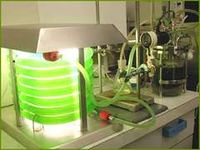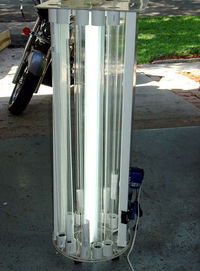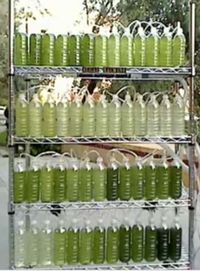Project:Algal biodiesel
Biodiesel production aims to use vegetal or animal oils as a renewable substitute for ordinary diesel. The UK is presently committed to deriving at least 5% of all transport diesel from biodiesel by 2013. It has powered jetflight and (when mixed with ordinary diesel) UK trains. It would be interesting to start probing the possibility of homebrew production.
The Hackspace doesn't have a field, so we have to explore algal biofuels. Microalgae are also attractive because they provide much higher yields of biomass and fuels, 10-100 times higher than comparable energy crops, and algae biofuel is non-toxic, contains no sulfur, and is highly biodegradable.
Whilst it would be wonderful for the project to eventually be able to harness enough solar or heat energy to not require a net input of chemical or electrical energy, it's not likely that we can either source enough light or drive the reactions efficiently enough for this to be feasible.
More background (from Nature, free access): http://www.nature.com/nature/journal/v474/n7352_supp/full/474S015a.html
Process
Algal cultivation
Presumably aquatic algae (Hydrophilus) are the way forwards. Two alternatives: open pond or closed. There doesn't, for now, seem to be a problem with starting off in flasks (on a shaker table, for example) and then looking to move to slow-circulating streams through tubes wrapped around a light source (for example), and then seeing if we can scale up to south-facing rooftop raceways (wide, shallow circuits). Sources online suggest that culture density will increase to a point where light cannot penetrate more than 10cm.
Photobioreactor (PBR)
See photos, right
- http://www.oilgae.com/challenge/debate/building-low-cost-photobioreactors
- http://www.che.utexas.edu/eldridge-group/pdf/Aditya.pdf
- Photobioreactors: Design Considerations for Sustainable High-Yield Algal Oil Production - http://www.nrel.gov/biomass/pdfs/hu.pdf
- Microalgal Photobioreactors: Scale - up and Optimization - http://library.wur.nl/wda/dissertations/dis3423.pdf
- Photobioreactor Technology for Microalgae Cultivation - http://www.ecn.nl/fileadmin/ecn/units/bio/Overig/pdf/Publ19.pdf
- Closed Photobioreactors for Microalgal Cultivation - http://www.losda.org/cellreg.org/PDF/Tsoglin01.PDF
- http://www.algaelab.org/
Option 1: hybrid closed/open system with the culture passing coil wrapped around a light source
Things we probably need:
- a gentle water pump
- a tank (fishtank?)
- a light source (properties?)
- clear tubing (there is clear pvc tubing near the 3in1)
- a reservoir for urine (there is a urinal in the member's storage racks (!))
- pH strips (got! I'll bring them in - Braadli)
- a heater? (there is a fishtank heater(perhaps 2) in the white rack used to store cables)
Things that would be good to have
- sensors (opacity, temp, pH, etc)
- 2% CO2 (laser cutter exhaust?)
Option 2: highly parallelised recycled soda bottle system
- plastic water bottles
- some way of arranging the bottles to be exposed to a light source
- a nutrient (urine?) reservoir and feed system
Things that would be good to have
- sensors (opacity, temp, pH, etc)
- 2% CO2 (laser cutter exhaust?)
Conditions
Algae can have doubling times inferior to a day, so if the conditions are right, growth should be extremely fast.
We need to think about nutrients. Being able to rely on wastewater and other nutrient sources (used coffee grinds?) would be fantastic; perhaps initially we should use standard aquatic fertiliser to ensure nutrient stability and sterility.
A strain capable of living at high or low pH would help us keep the system sterile (without having to regularly drain it and clean it then re-innoculate) in much the same way as sourdough cultures create their own inhospitable conditions to keep parasites out. S. dimorphus tends to increase the pH 9reduce the acidity) significantly, and optimum pH is 8.2-8.7 ; mature cultures will consume CO2 faster and tend to push this up to 9 (which will inhibit growth) if not properly aerated.
- Temperature: anything over 35degC will probably be lethal to most algae we'd consider growing; anything below 16degC may result in quite slow growth, which presents us with an obvious problem during winter especially if attempting outdoor growth. S. dimorphus prefers 30degC, which is also not optimal for our purposes.
- Light: algae don't require constant exposure to sunlight; in fact, that might be harmful (another added benefit of circulation is to give cells a rest period). The wavelengths they need depend on what chlorophyll they carry; if we are using artificial light, we should perhaps see if we find out what the absorption spectra of the cells are and make sure we're not wasting electricity (and promoting photoinhibition) by bathing the cells in 'useless' light.
- Nutrients: some algae, including S. dimorphus, go into obesity (survival) mode when you deprive them of nitrogen, instead of continuing steady division. It seems self-evident that if nitrogen starvation kicks in too early, or lasts too long, you inhibit growth and encourage population stunting or collapse, respectively.
- Nitrogen: different algae prefer different nitrogen sources; S. dimorphus prefers urea.
http://www.slideshare.net/kabronic/maximization-of-scenedesmus-dimorphus-lipid-yield-for-the-production-of-biodiesel http://www.eere.energy.gov/biomass/pdfs/biodiesel_from_algae.pdf
Monitoring
Perhaps someone with Arduino smarts could design a system capable of monitoring temperature, pH and light absorption, allowing us to remotely monitor and log growth, make adjustments and comparisons between growth rates.
Strain selection
Here's a table with different algae and their oil content: http://www.oilgae.com/algae/comp/comp.html Here's a commercial source (US based; any domestic/EU based alternatives?) www.utex.org
Harvesting
Harvesting means removing cells from the tank and somehow separating them from the water; you want a paste of at least 15% solids before attempting oil extraction. Harvesting will be a relatively big challenge, if the wider field's reported experiences are to be believed. There are several options:
- Chemical flocculation links the cells into a big mass that can be filtered more easily than individual cells; it might also tend to float or sink, allowing separation by sedimentation. Lime or alum sulphate could be used.
- Centrifuge the cells into a pellet
- Froth flotation
- Ultrasound
- Speculative: Air dry? Boil?
Oil extraction
Cell disruption
Oil extraction/purification
Chemical: hexane, isopropyl, acetone? Depends on the fatty acid we need to solubilise, the cell wall/membrane we want to break up, etc. This likely requires a lot of experimentation and reading.
Biodiesel production
http://journeytoforever.org/biodiesel.html
Transesterification
Whilst you can use the oil obtained above directly, you get a much more useful fuel if you convert the fatty acids to biodiesel. Here we'll use a base (Sodium hydroxide or potassium hydroxide, most likely; lime can also probably be used) to catalyse the reaction between alcohol (which we'll add; probably methanol) and the fatty acid/triglycerides produced in the previous step. This will produce our end product and glycerol, which is denser so should separate out. Ideally we're only getting 2% byproduct on this step, but if we get more, don't worry; if you've seen Fight Club, think back to how they're producing soap. Similar, eh?
Distillation
Storage
Quality testing
Future directions
- Find applications for the oil!
- The process can doubtless be endlessly tweaked, but biochemical enhancements could be investigated, such as adding certain inhibitors to shunt carbohydrate production in the cells towards long-chain oils, away from sugars; this could be done with chemical additives or genetic engineering (if we go down that path at all).


